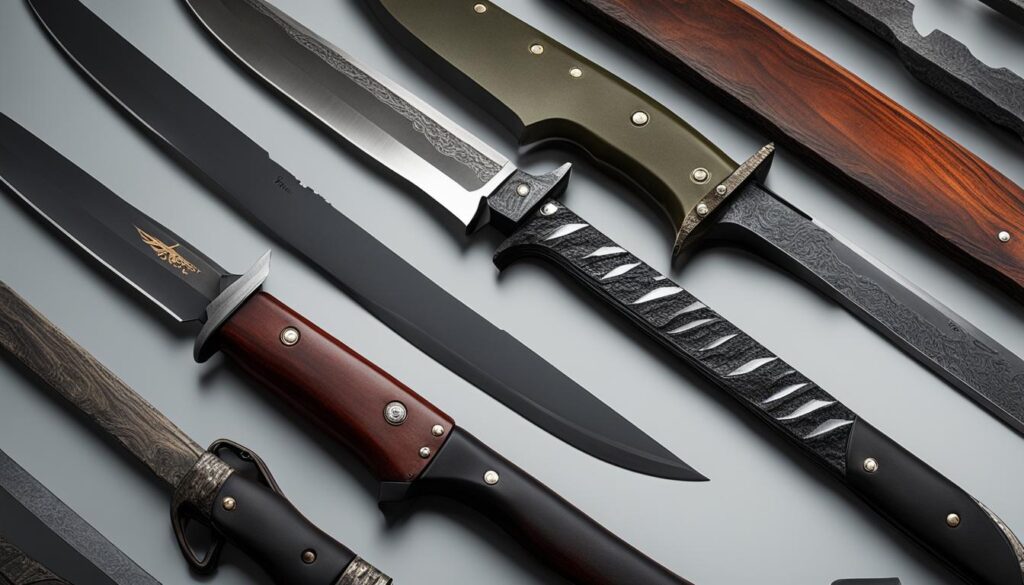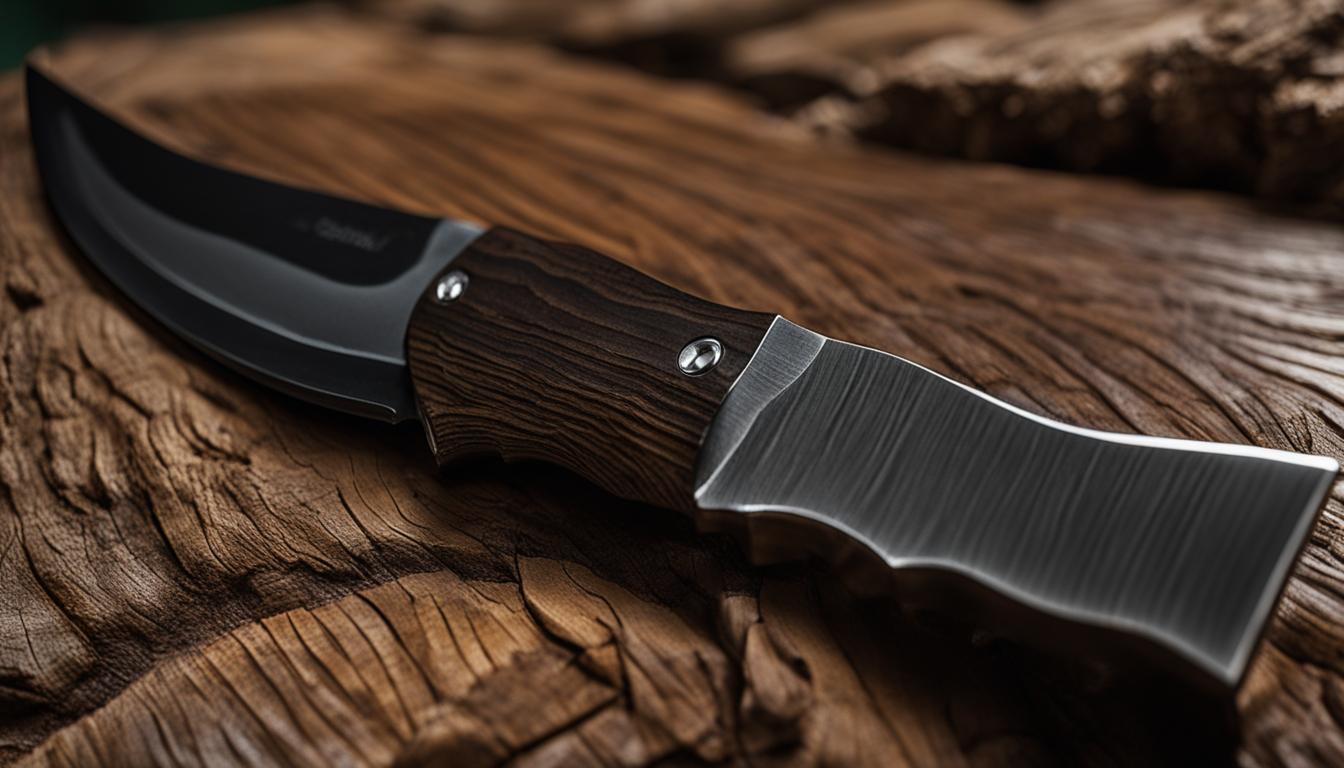When it comes to choosing a hunting knife, one important factor to consider is the blade length. Finding the perfect blade length can greatly enhance your hunting experience, providing you with the right balance of versatility and control. In this article, I will provide you with some recommendations and tips to help you determine the ideal blade length for your hunting knife.
Key Takeaways:
- Blade length ranging from 3 to 5 inches offers a good balance between versatility, control, and specific hunting tasks.
- A shorter blade provides more control and precision, while a longer blade offers more reach.
- Consider personal preferences, hunting styles, and the specific game being hunted when choosing the blade length.
- Blade shape, steel type, and intended use of the knife should also be considered in the decision-making process.
- Ultimately, choose a hunting knife that meets your needs and feels comfortable in your hand for a successful hunting experience.
Factors to Consider When Choosing a Hunting Knife
When it comes to choosing a hunting knife, there are several important factors that you need to consider. These factors will determine the functionality and suitability of the knife for your specific hunting needs. From the shape of the blade to the type of steel used, each aspect plays a crucial role in ensuring that you have the right tool for the job.
Blade Shape
The shape of the blade is one of the key considerations when choosing a hunting knife. Different blade shapes offer varying levels of control and functionality for specific tasks. For example, a clip point blade with its straight spine and clipped-off tip provides balance and control, making it suitable for a wide range of hunting tasks. On the other hand, a drop point blade positions the tip below the spine, making it ideal for precise cutting and carving.
Blade Length
The length of the blade is another important factor to consider. A shorter blade offers more control, making it ideal for tasks that require precision and detail. However, a longer blade provides greater reach, which is beneficial for tasks like skinning larger game animals. It’s essential to find the right balance between control and reach based on your specific hunting needs.
Type of Steel
The type of steel used in the blade determines its durability, edge retention, and overall performance. Stainless steel blades are known for their corrosion resistance and low maintenance, making them a popular choice among hunters. Non-stainless tool steels, such as O1 and D2, offer excellent edge retention and toughness. Consider the environment in which you’ll be using the knife and your personal preferences when selecting the type of steel.
| Factors | Considerations |
|---|---|
| Blade Shape | Choose a shape that suits your specific hunting tasks and provides the desired level of control. |
| Blade Length | Consider the trade-off between control and reach when selecting the blade length for your hunting knife. |
| Type of Steel | Take into account the durability, edge retention, and maintenance requirements of different steel types. |
By considering these factors when choosing a hunting knife, you can ensure that you have a tool that meets your specific needs and preferences. Whether you prioritize control, reach, or durability, finding the right balance is essential for a successful hunting experience.
Different Blade Shapes for Hunting Knives
When it comes to hunting knives, the blade shape plays a significant role in determining its functionality and effectiveness. Different blade shapes offer unique advantages and are suited to specific hunting tasks. Understanding the various options can help you choose the right blade shape for your hunting needs.
Clip Point Blade Shape
The Clip Point blade shape is characterized by a straight spine and a clipped-off tip. This shape offers excellent balance and control, making it versatile for a variety of hunting tasks. The clipped tip allows for precise cutting and piercing, making it ideal for delicate tasks like field dressing and detail work.
Drop Point Blade Shape
The Drop Point blade shape is one of the most popular choices among hunters. It features a curved blade with the tip positioned below the spine, creating a broader, more robust point. This shape provides excellent control and is well-suited for general hunting tasks, including skinning and field dressing. The drop point allows for easy maneuverability and reduces the risk of puncturing internal organs during field dressing.
Trailing Point Blade Shape
The Trailing Point blade shape is characterized by a long, curved spine that positions the tip above the spine. This shape is specifically designed for skinning game animals. The curved blade allows for smooth, effortless slicing motions, minimizing the risk of damaging the hide. It is particularly effective when skinning large game animals with expansive hides.
| Blade Shape | Advantages | Suitable Tasks |
|---|---|---|
| Clip Point | Balance and control | Field dressing, detail work |
| Drop Point | Control and versatility | Skinning, field dressing |
| Trailing Point | Effortless slicing | Skinning large game animals |
Choosing the Right Blade Shape for You
When selecting a hunting knife, consider the types of hunting tasks you anticipate performing most frequently. If you require a versatile blade for a range of tasks, the Clip Point or Drop Point shapes may be ideal. For hunters focused on skinning larger game animals, the Trailing Point shape offers the best performance. Ultimately, choosing the right blade shape is a matter of personal preference and the specific hunting activities you plan to undertake.
Now that you have a better understanding of the different blade shapes available for hunting knives, you can make an informed decision when choosing your next hunting companion.

The Importance of Blade Length for Hunting Knives
When it comes to hunting knives, the blade length plays a crucial role in determining its functionality and effectiveness. The right blade length can greatly enhance your hunting experience and make tasks easier and more efficient. Understanding the importance of blade length is essential for selecting the perfect hunting knife for your needs.
One of the key factors to consider when choosing the ideal blade length is the specific hunting tasks you will be undertaking. A shorter blade, typically ranging from 3 to 4 inches, offers more control and precision, making it ideal for field dressing small game and performing detailed tasks such as skinning. The shorter length allows for better maneuverability and accuracy, ensuring clean and precise cuts.
On the other hand, if you’re hunting larger game animals, a longer blade may be more suitable. A blade length of 4 to 5 inches provides increased reach, making it easier to skin and process larger animals. The longer blade allows for more efficient and effective cutting, reducing the effort required for tasks like quartering or boning out the carcass.
| Blade Length | Advantages | Disadvantages |
|---|---|---|
| Shorter (3-4 inches) | Increased control and precision | Limited reach for larger game |
| Longer (4-5 inches) | Greater reach for larger game | Slightly reduced control |
It’s important to note that the ideal blade length ultimately depends on personal preference and the specific hunting activities you plan to engage in. Some hunters may prefer a shorter blade regardless of game size, while others may opt for a longer blade for versatility or specific purposes. It’s crucial to choose a blade length that aligns with your needs and feels comfortable in your hand to ensure a successful hunting experience.
Remember, the right blade length can make all the difference in the field, improving your control, precision, and overall hunting efficiency. Consider your hunting tasks, game size, and personal preferences when selecting a hunting knife with the perfect blade length.
Understanding Steel Types for Hunting Knife Blades
When it comes to hunting knife blades, understanding the different steel types available is crucial in selecting the right tool for your needs. The quality and characteristics of the steel used in the blade directly impact its durability, edge retention, and overall performance in the field.
There are various steel types commonly used for hunting knife blades, each with its own set of advantages and disadvantages. One popular option is stainless steel, which is known for its corrosion resistance and low maintenance requirements. Stainless steel blades are less likely to rust or tarnish, making them ideal for use in outdoor environments where moisture is prevalent.
On the other hand, non-stainless tool steels like O1 and D2 offer superior edge retention and toughness. These blades are highly durable and can withstand heavy use without losing their sharpness. However, they may require more maintenance and care to prevent rust and corrosion.
It’s important to consider your specific needs and preferences when choosing the steel type for your hunting knife blade. If you prioritize ease of maintenance and resistance to corrosion, stainless steel may be the best option for you. But if you value exceptional edge retention and toughness, non-stainless tool steels may be more suitable for your hunting adventures.
Table: Comparison of Steel Types for Hunting Knife Blades
| Steel Type | Advantages | Disadvantages |
|---|---|---|
| Stainless Steel | Corrosion-resistant | Lower edge retention compared to non-stainless tool steels |
| O1 Steel | High edge retention | Requires more maintenance to prevent rust |
| D2 Steel | Excellent toughness and edge retention | May be more challenging to sharpen |


It’s worth noting that the choice of steel type should align with your anticipated use of the hunting knife. If you plan on hunting in wet or humid environments, stainless steel’s resistance to corrosion can be advantageous. Conversely, if you prioritize durability and longevity, non-stainless tool steels may be a better fit.
Ultimately, understanding the pros and cons of different steel types for hunting knife blades allows you to make an informed decision based on your specific requirements. Whether you prioritize corrosion resistance or edge retention, selecting the right steel type ensures that your hunting knife serves you reliably for years to come.
Conclusion
Finding the perfect blade length for your hunting knife is essential for optimal performance in the field. Considering factors such as versatility, control, and specific hunting tasks is crucial in making the right choice. After careful evaluation, it is generally recommended to select a blade length between 3 to 5 inches for a balanced and versatile hunting experience.
However, it is important to remember that individual preferences and hunting styles can influence the ideal blade length for each hunter. Some may prefer a shorter blade for precision tasks like field dressing, while others may opt for a longer blade for skinning or processing larger game animals.
In addition to blade length, other factors such as blade shape and steel type should also be considered when choosing a hunting knife. The shape of the blade determines its functionality for specific tasks, while the type of steel used affects durability and edge retention.
Ultimately, the key to selecting the perfect hunting knife lies in finding a blade length, shape, and steel type that meets your specific needs and feels comfortable in your hand. By considering these factors and making an informed decision, you can enhance your hunting experience and ensure the success of your endeavors in the great outdoors.
FAQ
What is the ideal blade length for a hunting knife?
The ideal blade length for a hunting knife ranges from 3 to 5 inches, offering a good balance between versatility, control, and specific hunting tasks.
How does the blade shape affect the functionality of a hunting knife?
The blade shape of a hunting knife can impact its functionality for tasks like skinning and carving. Different blade shapes, such as Clip Point, Drop Point, and Trailing Point, serve different purposes and offer varying levels of control and precision.
How does the blade length affect a hunting knife’s reach and control?
A shorter blade provides more control and precision, while a longer blade offers more reach. The choice of blade length depends on the specific hunting tasks and personal preferences.
What are the advantages and disadvantages of stainless steel versus non-stainless tool steel for hunting knife blades?
Stainless steel is corrosion-resistant and requires less maintenance, while non-stainless tool steels like O1 and D2 offer better edge retention and toughness. The choice of steel type depends on factors like expected use, the environment, and personal preferences.
What factors should I consider when choosing a hunting knife?
When choosing a hunting knife, factors like blade shape, blade length, and steel type should be considered. It’s important to determine the specific hunting tasks, personal preferences, and the environment the knife will be used in.





